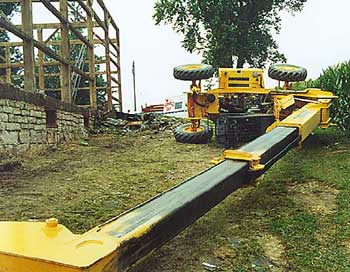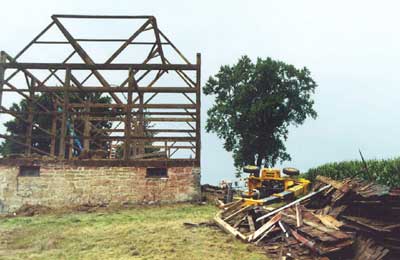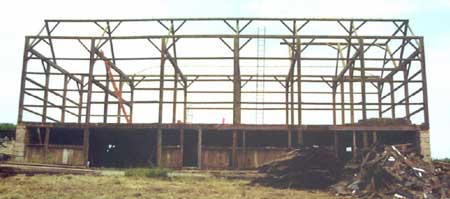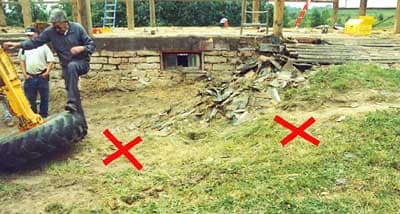Worker Falls to His Death in a Telescoping Boom Forklift Overturn
Iowa Case Report: 03IA043
Report Date: August 8, 2004
Summary
During the summer of 2003, a 19-year-old construction worker died after falling 30 ft. (9 m) from the forks of a telescoping boom forklift. He was member of a five-man crew hired by a local greenhouse company to dismantle and relocate a large old barn. The company owner rented the forklift from a local rental service, where he received training in the basic operations of the machine. The owner’s adult son was operating the forklift at the time of the incident. It was positioned partially on a driveway on the west side of the barn. The right wheels were on the driveway ramp and the left wheels were at a lower elevation on grass. The frame leveling control was set at its maximum position (12 degrees) to compensate for the sloping ground. The crew was removing the second rafter section that morning, taking apart joints and lowering sections to the ground. The victim was on the ground and rode up on the forks of the forklift, attaching the rafter to the forks with nylon straps, one strap to each fork. The operator then raised the rafter section up off the barn, with the victim standing on the forks, riding down with the load. At the top of this movement, the rafter piece and the machine suddenly shifted to the left. The machine fell over on its left side; the rafter crashed to the ground; and the victim jumped or fell to a grassy area on the ground. Emergency rescue was immediately called, and quickly transported the victim to a local hospital, but the man was dead on arrival due to severe internal bleeding. The operator of the forklift received minor injuries.
 |
|
Photo 1 – View from the northwest of barn showing the overturned forklift adjacent to the barn driveway.
|
Recommendations based on our investigation are as follows:
- A telescoping boom forklift should not be used on an incline which exceeds the limits of the frame leveling system.
- If a telescoping forklift truck is used to lift people, both the personnel platform and working procedures should comply with ASME standards (ASME B56.6-1992).2
- Employees should be adequately trained before operating lifting and hoisting equipment.
- Employers must provide fall protection for employees working 6 ft. (1.8 m) or more above the lower level.
 |
|
Photo 2 – View from the north side of the barn, showing the barn structure, the overturned forklift, and the broken rafter section lying next to the pile of discarded roofing.
|
Introduction
During the summer of 2003, a 19-year-old man was killed while helping to dismantle a barn, using a telescoping boom forklift. The Iowa FACE program was notified of this incident a few days later and began an investigation. Sources of information included newspapers, the county Sheriff, the medical examiner, individuals from the company, the forklift manufacturer, the rental company which owned the machine, eyewitnesses, OSHA, and an insurance company. Photographs of the scene were received from the county Sheriff.
The employer was a small local greenhouse company. The owner had hired a work crew to dismantle and relocate an old barn. He rented a telescoping boom forklift and received operational instruction from the rental company, but it is unknown how much of this training was transferred to his son, who operated the forklift. Little information is available about this company, for the owner and his son were unwilling to talk about this incident.
Investigation
The greenhouse company had purchased an old barn (peg barn), and was dismantling it for construction at a new location. The company owner hired five workers who were experienced in mortise and tenon / peg joinery construction. They had removed the roof and siding of the barn, and on the day of the incident, were disassembling the large rafter timbers supporting the roof (see Photo 3). Three of the men were climbing in the rafters. The victim was on the ground, and the fifth man was holding a rope to guide the rafter sections as they were lowered.
 |
|
Photo 3 – View from the east of the barn showing the barn architecture and second pile of debris.
|
The greenhouse company owner rented a telescoping boom forklift from a local rental company, which provided basic training in operating the machine. No specific safety training was provided. The owner’s son operated the machine on site. It is unknown how much training he received in operating this machine and related safety issues. The machine was a JCB model 508C, manufactured in 2000. It had 8000 lb. (3600 kg) lift capacity, and a maximum lift height of 41.5 ft. (12.5 m). The forklift had a frame leveling system, which could compensate for about 12 degrees of incline to either side. The tires were fluid-filled. The machine had no stabilizers (outriggers).
The dimensions of the barn were approximately 90 x 48 ft. (27 x 14.5 m). The frame was built of fir timbers, mostly 6”x 8” (150*200 mm) or 8” x 10” (200*250 mm) in size. At the time of the incident, the forklift was located on the west side of the barn. The terrain around the barn was sloping to the north. The roof and sides of the barn had been removed earlier and were lying in piles of debris on each side of the barn. The five men hired to dismantle the barn were experienced in relocating old barns of this type, and had recently moved another barn using a similar boom forklift from the same local rental company.
The men had already lowered one section of the rafters that morning. The forklift was re-positioned for the next section near the barn driveway / ramp on the west side of the barn. The operator positioned the forklift in the middle of the rafter section. This put the right wheels of the forklift in the driveway / ramp area, with the left wheels lower in grass to the side (see Photo 4). The frame leveling control was used to compensate for the sloping ground, and it was in its maximum position. It was the crew’s normal procedure for one man to ride up on the forklift to secure the beams to the forks, then, ride back down with the load. There was no personnel platform attached to this forklift, but the victim rode up on the forks of the machine. The forks were raised above the center portion of the rafter section and the section was secured with nylon slings to the forks. While the forklift provided support, other workers used pry bars and other tools to carefully remove pegs and loosen the joints. Once loose, the forklift would raise the section until it was free from the barn and then lower it to the ground in front of the forklift.
When the rafter section was raised sufficiently to clear the barn, it began to sway slightly. This was not unusual, as it was difficult to determine the exact center of gravity for the rafter sections. The forklift boom was not fully extended at this point, but was elevated to approximately 30 ft. (9 m). Suddenly, as the operator began to lower the rafter section, the load and the forklift began to fall to the left (north). The co-workers yelled and warned the victim but he had no safe escape. The forklift fell to the ground and the rafter section crashed and broke up next to the pile of roof debris. The victim rode partway down with the load, then, jumped and fell into the grass north of the barn. Rescue workers were called, and arrived in a few minutes, but the man had received internal injuries and was declared dead when transferred to the local hospital.
The forklift was tested later by the rental company and was found to be in normal working condition. The machine was not damaged in the incident, therefore, it received minor repairs and was put back into service.
The company was cited by OSHA for failure to provide a guardrail system, safety net system, or personal fall arrest systems for its workers. They were also cited for not providing adequate training to the forklift operator regarding safe operation of the machine, the limitations of the machine, and the requirements for stability.
 |
|
Photo 4 – View from the west of the barn, showing the approximate positions of the front wheels of the forklift, with the right wheel higher than the left due to the barn driveway.
|
Cause of Death
The official cause of death was, “chest trauma, lacerated left ventricle due to fall.” An autopsy was performed, which confirmed these findings.
Recommendations/Discussion
Recommendation #1: A telescoping boom forklift should not be used on an incline which exceeds the limits of the frame leveling system.
Discussion: The frame-leveling system for this forklift was set at maximum tilt to compensate for the sloping ground. However, it appears that the incline was greater than the capacity of the leveling system. When a load is carried low, the machine is fairly stable. However, the weight and height of the load will work together to change the overall center of gravity of the machine. If the center of gravity at any time shifts beyond the tires of the machine, the machine will overturn. Factors that appear active during this incident are the ground sloping at / over the capacity of the leveling system, the raised boom, forces from the weight and swinging of the load, lack of outriggers, and machine movements. Other factors which could contribute to overturning include: tire pressure, soil/surface conditions, wind speed and direction, swaying of the load, and movements (driving, turning, braking) of the machine. In addition, the ground slope was not uniform for front and rear wheels. The ramp incline created a greater slope angle for the front wheels compared to the rear wheels. This might have also compromised the machine’s stability or influenced the effectiveness of the frame-leveling system.
Recommendation 2: If a telescoping forklift truck is used to lift people, both the personnel platform and working procedures should comply with ASME standards (ASME B56.6-1992).2
Discussion: Many construction companies equip a rough terrain forklift truck with personnel platforms, and it is accepted practice, provided the platform and work procedures conform to standards set by ASME. Some manufacturers have engineered their own platforms for their machines, and these are certainly preferred if available. Manufactured personnel platforms are the proper size for a particular model, have solid means of anchoring to the forks, have approved guardrails, and most importantly, have been tested to comply with standards. For a complete summary of standards for a personnel platform, see the references below.2 It should be noted that boom forklifts may be equipped with worker platforms with guardrails, however conventional fall arrest systems must still be used. While this type of platform is useful in providing fall protection, it does not help in the case of machine overturn, and ensuring the stability of the machine is imperative.
In this incident, no type of personnel platform was used, and the victim simply rode up and down on the forks of the machine, a practice which is commonly seen, but never approved. Even when approved personnel platforms are used on a forklift, working procedures and limits should be modified accordingly. Most personnel platforms are used with various building materials and tools onboard, i.e. shingles, siding, windows, saws, etc. ASME standards state in this situation, the combined weight of the platform, load, and personnel should not exceed one-third of the rated capacity of the forklift in any position of the boom. This is to provide an extra margin of safety when working with elevated personnel, and applies whenever personnel and equipment are lifted together. [See ASME B56.6-1992, 5.15.1(t)]
Recommendation 3: Employees should be adequately trained before operating lifting and hoisting equipment.
Discussion: As specified under CFR 1910.178(l)(1)(ii) and referenced by CFR 1926.602(d), employers must ensure that operators of powered industrial trucks are properly trained. Such operator training must include truck-related topics contained in 1910.178(l)(3)(i) and (ii). In this case, the company owner received verbal operational instructions from the rental company, but did not receive specific safety training. It is unknown how adequate this instruction was initially, or how much of it was transferred to the operator. Proper instruction for the operator should include basic operation and machine limitations, vehicle stability on sloped surfaces, surface conditions where the truck would be operated, load manipulation, fork and attachment adaptations, and other warnings, and precautions contained in the vehicle’s operator’s manual.
Family businesses may have complex power / authority structures as the employer-employee and family roles are intertwined. Our investigation was not able to obtain information about the specifics of safety programs or training within this company but it appears that the training of the machine operator was inadequate, considering the hazardous nature of the machine, task at hand, work location, and work crew.
Recommendation 4: Employers must provide fall protection for employees working 6 ft. (1.8 m) or more above the lower level.
Discussion: As specified under CFR 1926.501(b)(1), employers must provide employees with fall protection if they are walking or working on elevated surfaces 6 ft. or more above the lower level, and the working surface or platform has unprotected sides or edges. Prior to this incident the victim and other employees where working without fall protection from beams approximately 15-20 ft. (4.5 – 6 m) above the floor level while dismantling the barn frame posts and beams. The victim was working at a higher level, completely unprotected.
Dismantling an old barn is a hazardous assignment, and it is difficult to offer effective and practical fall-protection guidelines for this situation. Use of a conventional fall arrest system (anchor points, lifelines, and body harnesses) is difficult, or impossible to implement, for in many situations there are no secure anchor points to use. Likewise, the use of long extension ladders is risky, as the joints are loosened, and posts, beams, and supports are being dismantled as part of the work. One option may be to use scissor lifts which have guardrails installed around the worker’s platform. This assumes the floor of the barn is sufficiently level and solid to support a scissor lift. This would allow safer access to disconnecting beams from underneath, and workers would not need to take the dangerous ride up with the forklift. In addition, workers on the lift platform with guardrails would not need to use fall protection.
References
- CFR 1926.501(b)(1).
- ASME, American Society of Mechanical Engineers, Safety Standard For Rough Terrain Forklift Trucks, (ASME B56.6-1992), (Part II, Section 5.15.1, a-y) and (Part III, Section 8.1–8.26) Also see (ASME B56.6-a-1994 Addenda) (Part III, Section III) for several revisions for manufacturers.
Iowa FACE Program
FACE is an occupational fatality investigation and surveillance program of the National Institute for Occupational Safety and Health (NIOSH). In the state of Iowa, The University of Iowa, in conjunction with the Iowa Department of Public Health carries out the FACE program. The NIOSH head office in Morgantown, West Virginia, carries out an intramural FACE program and funds state based programs in Alaska, California, Iowa, Kentucky, Massachusetts, Michigan, Minnesota, Nebraska, New Jersey, New York, Oklahoma, Oregon, Washington, West Virginia, and Wisconsin.
The purpose of FACE is to identify all occupational fatalities in the participating states, conduct in depth investigations on specific types of fatalities, and make recommendations regarding prevention. NIOSH collects this information nationally and publishes reports and Alerts, which are disseminated widely to the involved industries. NIOSH FACE publications are available from the NIOSH Distribution Center (1-800-35NIOSH).
Iowa FACE publishes case reports, one page Warnings, and articles in trade journals. Most of this information is posted on our web site listed below. Copies of the reports and Warnings are available by contacting our offices in Iowa City, IA.
The Iowa FACE team consists of the following from the University of Iowa: Craig Zwerling, MD, PhD, MPH, Principal Investigator; Wayne Johnson, MD, Chief Investigator; John Lundell, MA, Coordinator; Risto Rautiainen, PhD, Co-Investigator, and John Kraemer, PA. from the Office of The State Medical Examiner.
To contact Iowa State FACE program personnel regarding State-based FACE reports, please use information listed on the Contact Sheet on the NIOSH FACE web site Please contact In-house FACE program personnel regarding In-house FACE reports and to gain assistance when State-FACE program personnel cannot be reached.

